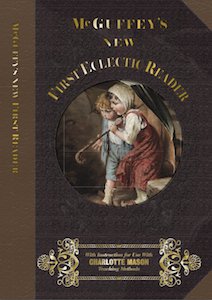This latest incarnation of McGuffey’s Readers has beautiful covers and an attractive layout, but those features are not sufficient motivation for me to review yet another version of these famous readers. However, this series deserves my attention since it combines McGuffey’s presentation with Charlotte Mason’s methodology.
Janice Campbell has added a 17-page section at the beginning of each reader titled, “Mr. McGuffey, Meet Charlotte Mason” where she explains how the ideas of these two educators can be combined to great benefit. She praises McGuffey’s wide range of literary works used in his readers as well as his lessons on articulation and rhetoric—subjects rarely taught today. From Charlotte Mason, this series draws upon the use of copywork, recitation, narration, dictation, and writing from models.
Campbell explains, “Mason and McGuffey both understood that education is for the purpose of gaining wisdom and virtue, and they designed methods and materials to meet that goal. These methods are time-tested and proven, and when you pair Mason’s language arts sequence with McGuffey’s material, you have a curriculum that in Miss Mason’s words tends ‘to simplification, economy, and discipline.’” (Third Eclectic Reader, p. xv).
The six readers in the series include the original content from the 1857 editions in their entirety, including their mentions of God. Campbell’s instructions explain how to apply Mason’s methodology with general instructions that apply throughout each book, although parents must decide when to introduce each new method.
Questions followed some of the readings in McGuffey’s original books, and those are included here. Some questions fit well with Mason’s methodology. For example, a story in the Third Eclectic Reader concludes with this exercise: “Relate this story. How can boys secure a good name? What advantage is there in having one?” (p. 138). The first instruction—to relate the story—is essentially asking the child for an oral narration. The following two questions require students to think beyond the content of the story for their answers. This guided discussion stretches beyond narration but still fits the spirit of Charlotte Mason’s ideas. Other stories have simple comprehension questions; while these might be useful in classroom situations, Campbell suggests skipping such questions and instead applying Mason’s methods.
Stories and word usage will sometimes seem archaic to modern students, but if parents work closely with children, this aspect of the readers can also be an educational tool to help children understand changes in language and customs over time.
The six readers are not assigned to grade levels, but they progress in difficulty. You will likely spend more than one year with some of the readers.
The First Reader very briefly introduces the sounds of the letters and immediately moves into reading short vowel words, including words such as “catch” and “black.” By the end of the First Reader, children are reading a poem: “Hear the chil-dren gay-ly shout! ‘Half past four, and school is out!’” (Syllable divisions are included in this version to assist children in their reading.) This reader moves much too quickly to serve as your introductory phonics program, so you will need to use something else for teaching introductory reading skills. However, you might still begin to use this reader with first graders. The series can be used all the way through high school as part of your reading and language arts program.
Articulation and rhetoric lessons are introduced gradually. Articulation lessons are included in the Second and Third Readers, although they are very simple at first. Mason’s recitation methods can also begin at the earliest levels as suggested by Campbell. In the Fourth Reader, pages 8 through 30 are devoted to instruction in "marks and pauses," articulation, pronunciation, and inflection, with additional exercises and reminders throughout. The Fifth Reader begins with 27 pages of instruction and examples for reading and recitation as a rhetorical exercise. Topics covered include: articulation; inflections; emphasis; modulation; poetic pauses; and conveying the meaning of the story, essay, or poem. This section concludes with five short literary selections with which to practice these skills The Sixth Reader has instruction similar to that in the Fifth Reader, but it adds instruction in voice management and gestures.
Students will need to be reading additional literature—especially entire books. While students might complete some of their composition work through these books, they will still need more comprehensive instruction in that area as well. This McGuffey series might serve as your primary reading program for the elementary grades, supplemented by additional reading material. For older students, the series is more likely to work best as a supplement.
Many other resources that teach Charlotte Mason methodology use material very similar to that in the McGuffey Readers, including the fascinating etchings used as illustrations. So this pairing of the McGuffey material with Mason’s methodology seems very natural. I’m just surprised that no one else thought to do this sooner.









